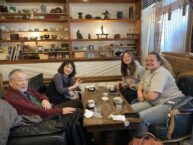For my CIP, I volunteered at the Kyoto ani Love Animal Shelter for cats and dogs. Since this was the first time KCJS students volunteered at the shelter, Nakata-sensei went along with me and another student during our first visit to the shelter. Since I got to volunteer alongside another student, it made the first few sessions a lot less daunting.
During the first session, the staff members gave me a presentation which explained the purpose of the shelter, the situation of stray or abandoned cats and dogs in Kyoto, the laws that the shelter has to follow, and how the shelter generally operates. I also got to discuss how the situation and shelter differs in the U.S. and in Taiwan and ask any lingering questions I had. Despite the abundance of new words that I haven’t learned at that point, the presentation itself was easy to follow. During the following volunteer sessions, the volunteer work I did at the shelter was similar to those of a normal animal shelter although a lot less taxing. I got to take the dogs on a walk, teach them to follow orders such as ‘stop’ and ‘wait’, and help the staff members groom them. Most of these activities involved giving them treats as rewards. The staff member was always there with me to help guide me through each volunteer work. I also had a chance to play with the cats and help the staff members clean their cages. My favorite part was that I got to bathe and groom one of the puppies at the shelter and help him become familiar with interacting with humans (since he was born as a stray dog). It was amazing to watch the dogs’ progress (e.g. in following orders) and to watch the puppies grow over the weeks I was there.
I was surprised by the amount of hospitality shown by the staff at the shelter. They were very welcoming and friendly. After the volunteer work was done each day and during the breaks, I had a chance to talk with the staff members. It was during these moments that I became much closer to them and this made it easier to work with them. I felt slightly bad that the staff members kept providing me with snacks and drinks since sometimes it made me feel like I was more of a guest than a volunteer. Nonetheless, it was during these moments that I got to learn new Japanese words related to the volunteer work. Many of the staff members had chosen to work at the shelter out of their love for cats and dogs.
Overall, I enjoyed the time I spent at Kyoto ani Love Animal Shelter and I feel truly grateful to have had the opportunity to volunteer there. If I have the chance to visit Kyoto again in the future, I will definitely drop by the shelter to visit the staff members and the dogs and cats there again. If you love animals or you’re missing your pets at home then this is a great CIP that I recommend.


